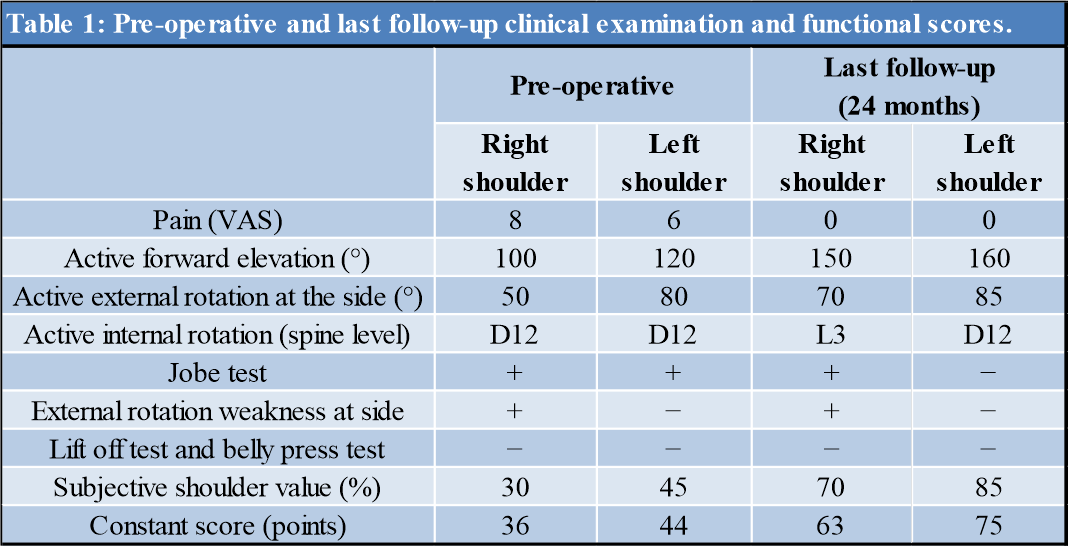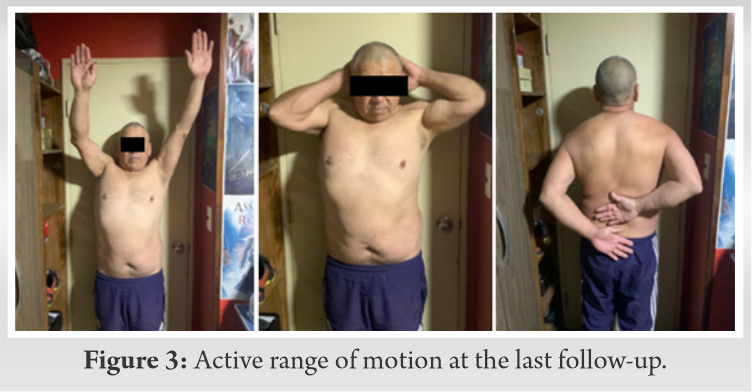This single-stage surgical treatment is an exceptional indication for a bilateral dysbaric humeral head osteonecrosis that can be considered in selected cases.
Dr. Gabriel Cárdenas,
Instituto de Seguridad del Trabajo, Viña del Mar, Chile.
E-mail: dr.gcardenaso@gmail.com
Introduction: Dysbaric osteonecrosis (DON) is a specific type of atraumatic osteonecrosis that has been shown to occur mainly in deep-sea divers and workers exposed to increased air pressure environments. The pathophysiology is not entirely understood but is thought to be due to subclinical decompression sickness resulting in arterial gas emboli. This leads to vascular occlusion and subsequent bone death.
Case Report: An active 56-year-old male diver presented with progressive bilateral shoulder pain and dysfunction due to bilateral DON of the humeral head and associated posterosuperior rotator cuff tearing. The diagnosis was confirmed by physical examination, X-rays, and magnetic resonance imaging. Due to failure of conservative treatment, a single-stage bilateral, subscapularis-sparing, stemless shoulder hemiarthroplasty with concomitant rotator cuff repair was performed. At 24-month follow-up, the patient showed satisfactory functional outcomes in both shoulders without complication.
Conclusion: This single-stage surgical treatment is an exceptional indication for a bilateral dysbaric humeral head osteonecrosis that can be considered in selected cases because may reduce the total recovery time and can be safe and effective at 24 months postoperatively.
Keywords: Dysbaric osteonecrosis, humeral head, rotator cuff.
Dysbaric osteonecrosis (DON) is a specific type of atraumatic osteonecrosis that has been shown to occur mainly in deep-sea divers and workers exposed to increased air pressure environments [1]. The pathophysiology is not entirely understood but is thought to be due to subclinical decompression sickness resulting in arterial gas emboli [2]. This leads to vascular occlusion and subsequent bone death [2]. The humeral head is the second most common anatomic site affected by atraumatic osteonecrosis following the femoral head [3]. Concomitant shoulder and hip avascular necrosis have been described in the setting of dysbarism (caisson disease) [4]. Bilateral humeral head osteonecrosis has been reported in 15% of multifocal cases [5]. Moreover, concomitant rotator cuff tears have been also described [5]. We report the case of a 56-year-old male diver diagnosed with bilateral dysbaric humeral head osteonecrosis with associated posterosuperior rotator cuff tearing. He was treated with a single-stage bilateral, subscapularis-sparing stemless shoulder hemiarthroplasty with concomitant rotator cuff repair.
An active 56-year-old male deep-sea diver with bilateral shoulder pain and dysfunction was referred for management of multifocal osteonecrosis involving the left knee and bilateral femoral and humeral heads. Prior treatment included a left total knee replacement, a failed core decompression of both femoral heads, and finally a staged bilateral total hip replacement. Pre-operative clinical examination and functional scores for the shoulders are summarized in (Table 1).
Grashey and axillary lateral plain films showed bilateral osteonecrosis of the humeral head (Cruess Stage III on the right and Cruess Stage II on the left) [6] (Fig. 1). The acromiohumeral index and the critical shoulder angle were 7.5 mm and 43° on right and 10 mm and 42° on left. The glenohumeral joint space was maintained and there were no signs of degenerative glenoid arthritis. Magnetic resonance imaging confirmed the diagnosis and also revealed bilateral rotator cuff tearing (Fig. 2).
The right shoulder had a medium size tear according to DeOrio and Cofield (22 mm in the anteroposterior dimension) with 28 mm of supraspinatus tendon retraction (Patte Stage 2) and a partial tear of the infraspinatus. Fatty infiltration was Fuchs Stage-2 in the supraspinatus and infraspinatus, and there was no fatty infiltration in the subscapularis muscle. The left shoulder had a small rotator cuff tear (7.5 mm in the anteroposterior dimension) with Patte Stage 1 retraction, no fatty atrophy, and no involvement of the infraspinatus.
The patient had failed many months of conservative treatment including oral anti-inflammatories and a home exercise program. His pain and dysfunction was progressive and a single-stage bilateral, subscapularis-sparing stemless shoulder hemiarthroplasty with a ceramic humeral head and concomitant rotator cuff repair was proposed. Clinical decision-making included: (1) Avoid total shoulder arthroplasty in a very active, young, male patient to mitigate the potential of early or mid-term glenoid component failure; (2) attempt to preserve native glenoid cartilage using a ceramic humeral head (pyrocarbon is not currently available in Chile); (3) perform a single-stage bilateral procedure as was the patient’s preference to reduce the total recovery time given his prior extensive surgical history; (4) use a subscapularis-preserving approach to facilitate early functional recovery; and (5) a concomitant rotator cuff repair to restore the rotator cuff force balance.
The patient was identified in the pre-operative holding area and a consent form was signed. General endotracheal anesthesia was administered without a regional interscalene block. The dominant right side was prepped and draped in the usual sterile fashion and the arm was placed on a standard surgical patient arm positioner. The preceding and following steps were first performed on the right and then repeated on the left. A standard deltopectoral approach was utilized with lateral retraction of the cephalic vein. A Browne deltoid retractor lateral and blunt Hohmann retractor medial revealed the posterosuperior rotator cuff and subscapularis. The biceps tendon was released proximally within the rotator interval and tenodesed in the distal bicipital groove. The subscapularis on both sides was completely intact and an “enlarged rotator interval window” was created by performing a limited (~5 mm) peel from the lesser tuberosity. An anatomic humeral neck cut was utilized to reveal the glenoid cartilage which was completely intact bilaterally. The stemless humeral implant (Affinis Short System, Mathys, Bettlach, Switzerland) was then inserted and the head size was trialed based on the resected humeral head. The final ceramic component was then impacted and the joint was reduced. Next, the rotator cuff was repaired using double-loaded titanium anchors (Healix Ti Dual Threaded Suture Anchor, DePuy Synthes, Raynham, MA, USA) (two on the right and one on the left) with a tension band suture technique. A lateral rotator interval closure to the upper round border of the subscapularis was then performed. The incisions were closed and both arms were placed in a sling. Postoperatively, passive motion was allowed immediately and active motion was permitted as tolerated. During hospitalization, the patient’s personal hygiene requirements were cared for by the nursing staff. After discharge, the patient used the left arm for personal care as his subjective and objective recovery on that side was accelerated compared to the right. Formal physical therapy to improve active range of motion was started at 6 weeks after surgery and strengthening at 12 weeks after surgery.
At 2-year follow-up, the patient is “very satisfied” with his overall outcome. He has returned to work without functional limitations. On clinical examination, there is no pain and there are improvements in all patient reported outcomes (Table 1; Fig. 3). X-rays show no signs of loosening of either prosthesis (Fig. 4). The acromiohumeral index is slightly decreased on the right and preserved on the left.
This case highlights single-stage surgical management of a rare presentation of bilateral dysbaric humeral head osteonecrosis with 24-month follow-up. There is no consensus in the current literature for treatment of these patients. Gerber et al. have highlighted the safety of a single-stage bilateral arthroplasty approach for select patient with severely symptomatic glenohumeral arthritis [7]. This may reduce the time spent to complete post-operative rehabilitation compared to a staged approach and theoretically allow patients a quicker return to work. To this end, a subscapularis-sparing approach was utilized. Many techniques have been described including a rotator interval approach [8], an inferior muscle belly release approach [9], and an approach through a chronic supraspinatus tear in the case of reverse shoulder arthroplasty [10]. In our patient, we used this latter approach and added a 5 mm peel of the upper third of the subscapularis which permitted excellent visualization throughout the procedure and were completed without complication. Hemiarthroplasty with rotator cuff repair was elected in this case given the age of the patient, his future physical demands, and intact glenoid cartilage preoperatively. Functional outcomes following hemiarthroplasty in the setting of rotator cuff deficiency are variable [11, 12]. Versier et al. reported inferior outcomes in those patients that required a concomitant rotator cuff repair compared with those who did not, particularly if the infraspinatus was involved [5]. This was discussed with the patient before surgery. His post-operative X-rays at 24 months do show superior migration of the humeral component on the right side which exhibited a partial infraspinatus tear before surgery. At last follow-up, he had no subjective complaints but decreased forward elevation and external rotator strength compared to the left. This will be followed with serial physical examination and radiographs to assess the need for revision to reverse shoulder arthroplasty in the future should that become indicated. A stemless humeral component was selected to preserve metaphyseal bone stock in this young patient [13]. Furthermore, a ceramic humeral head was used as there is some evidence suggesting that this biomaterial is less deleterious to normal and early-stage arthritic glenoid cartilage [14]. Pyrolytic carbon (pyrocarbon) is also a current option for the humeral head component. Although not available in Chile, it is a highly biocompatible material that generates little to no glenoid wear and is hypothesized to yield to longer durability [15]. Finally, glenoid resurfacing with total shoulder arthroplasty was also an option in this case but avoided to mitigate potential long-term glenoid implant-related complications [16, 17].
At 24-month follow-up after surgery, this active 56-year-old male diver is very satisfied with his overall outcome. This case highlights a rare clinical presentation with a unique surgical solution which takes into consideration surgical approach and implant selection. Mid- and long-term follow-up will determine the efficacy and durability of this technique which may serve as a viable option for select patients.
This single-stage surgical treatment is an exceptional indication for a bilateral dysbaric humeral head osteonecrosis that can be considered in selected cases.
References
- 1.Miyanishi K, Kamo Y, Ihara H, Naka T, Hirakawa M, Sugioka Y. Risk factors for dysbaric osteonecrosis. Rheumatology 2006;45:855-8. [Google Scholar]
- 2.White TC, Davis DD, Cooper JS. Dysbaric Osteonecrosis. Treasure Island, FL: StatPearls Publishing; 2020. [Google Scholar]
- 3.Harreld KL, Marulanda GA, Ulrich SD, Marker DR, Seyler TM, Mont MA. Small-diameter percutaneous decompression for osteonecrosis of the shoulder. Am J Orthop 2009;38:348-54. [Google Scholar]
- 4.Hasan SS, Romeo AA. Nontraumatic osteonecrosis of the humeral head. J Shoulder Elb Surg 2002;11:281-98. [Google Scholar]
- 5.Versier G, Marchaland JP, Basso M, Nove-Josserand L, Walch G. Résultats cliniques et radiologiques des prothèses d’épaule sur ostéonécrose aseptique de la tête humérale. E Mém Acad Natl Chir 2004;3:1-7. [Google Scholar]
- 6.Cruess RL. Experience with steroid-induced avascular necrosis of the shoulder and etiologic considerations regarding osteonecrosis of the hip. Clin Orthop Relat Res 1978;130:86-93. [Google Scholar]
- 7.Gerber C, Lingenfelter EJ, Reischl N, Sukthankar A. Single-stage bilateral total shoulder arthroplasty: A preliminary study. J Bone Joint Surg 2006;88:751-5. [Google Scholar]
- 8.Lafosse L, Schnaser E, Haag M, Gobezie R. Primary total shoulder arthroplasty performed entirely thru the rotator interval: Technique and minimum two-year outcomes. J Shoulder Elbow Surg 2009;18:864-73. [Google Scholar]
- 9.Simovitch R, Fullick R, Kwon Y, Zuckerman JD. Use of the subscapularis preserving technique in anatomic total shoulder arthroplasty. Bull NYU Hosp Joint Dis 2013;71:94-100. [Google Scholar]
- 10.Lädermann A, Lo EY, Schwitzguébel AJ, Yates E. Subscapularis and deltoid preserving anterior approach for reverse shoulder arthroplasty. Orthop Traumatol Surg Res 2016;102:905-8. [Google Scholar]
- 11.Gadea F, Alami G, Pape G, Boileau P, Favard L. Shoulder hemiarthroplasty: Outcomes and long-term survival analysis according to etiology. Orthop Traumatol Surg Res 2012;98:659-65. [Google Scholar]
- 12.Goldberg SS, Bell JE, Han JK, Bak SF, Levine WN, Bigliani LU. Hemiarthroplasty for the rotator cuff-deficient shoulder. J Bone Joint Surg Ser A 2008;90:554-9. [Google Scholar]
- 13.Churchill RS, Chuinard C, Wiater JM, Friedman R, Freehill M, Jacobson S, et al. Clinical and radiographic outcomes of the simpliciti canal-sparing shoulder arthroplasty system: A prospective two-year multicenter study. J Bone Joint Surg 2016;98:552-60. [Google Scholar]
- 14.Ajdari N, Tempelaere C, Masouleh MI, Abel R, Delfosse D, Emery R, et al. Hemiarthroplasties: The choice of prosthetic material causes different levels of damage in the articular cartilage. J Shoulder Elb Surg 2020;29:1019-29. [Google Scholar]
- 15.Hudek R, Werner B, Abdelkawi AF, Gohlke F. Interpositions-hemiprothese aus pyrocarbon bei fortgeschrittener humeruskopfnekrose. Orthopade 2017;46:1034-44. [Google Scholar]
- 16.Bonnevialle N, Melis B, Neyton L, Favard L, Molé D, Walch G, et al. Aseptic glenoid loosening or failure in total shoulder arthroplasty: Revision with glenoid reimplantation. J Shoulder Elb Surg 2013;22:745-51. [Google Scholar]
- 17.Fox TJ, Cil A, Sperling JW, Sanchez-Sotelo J, Schleck CD, Cofield RH. Survival of the glenoid component in shoulder arthroplasty. J Shoulder Elb Surg 2009;18:859-63. [Google Scholar]












